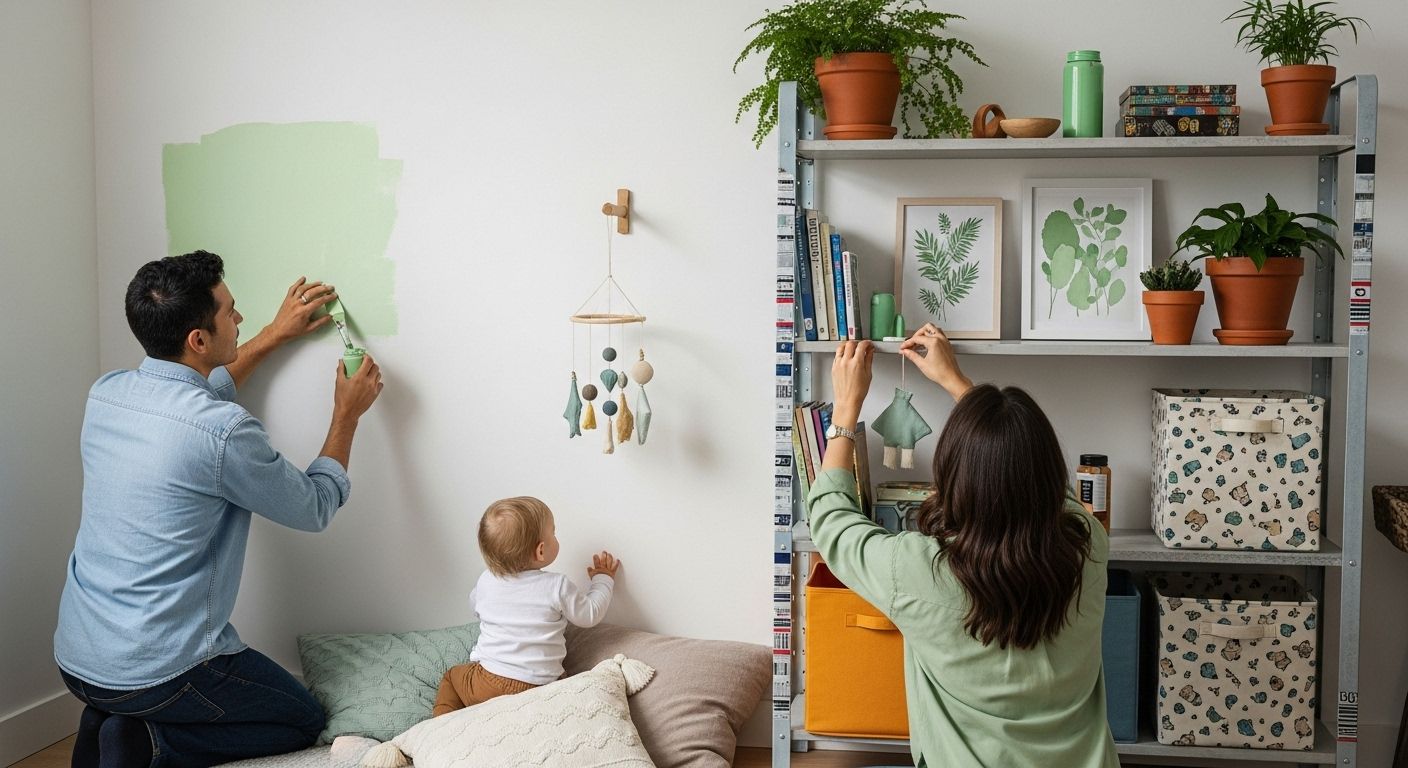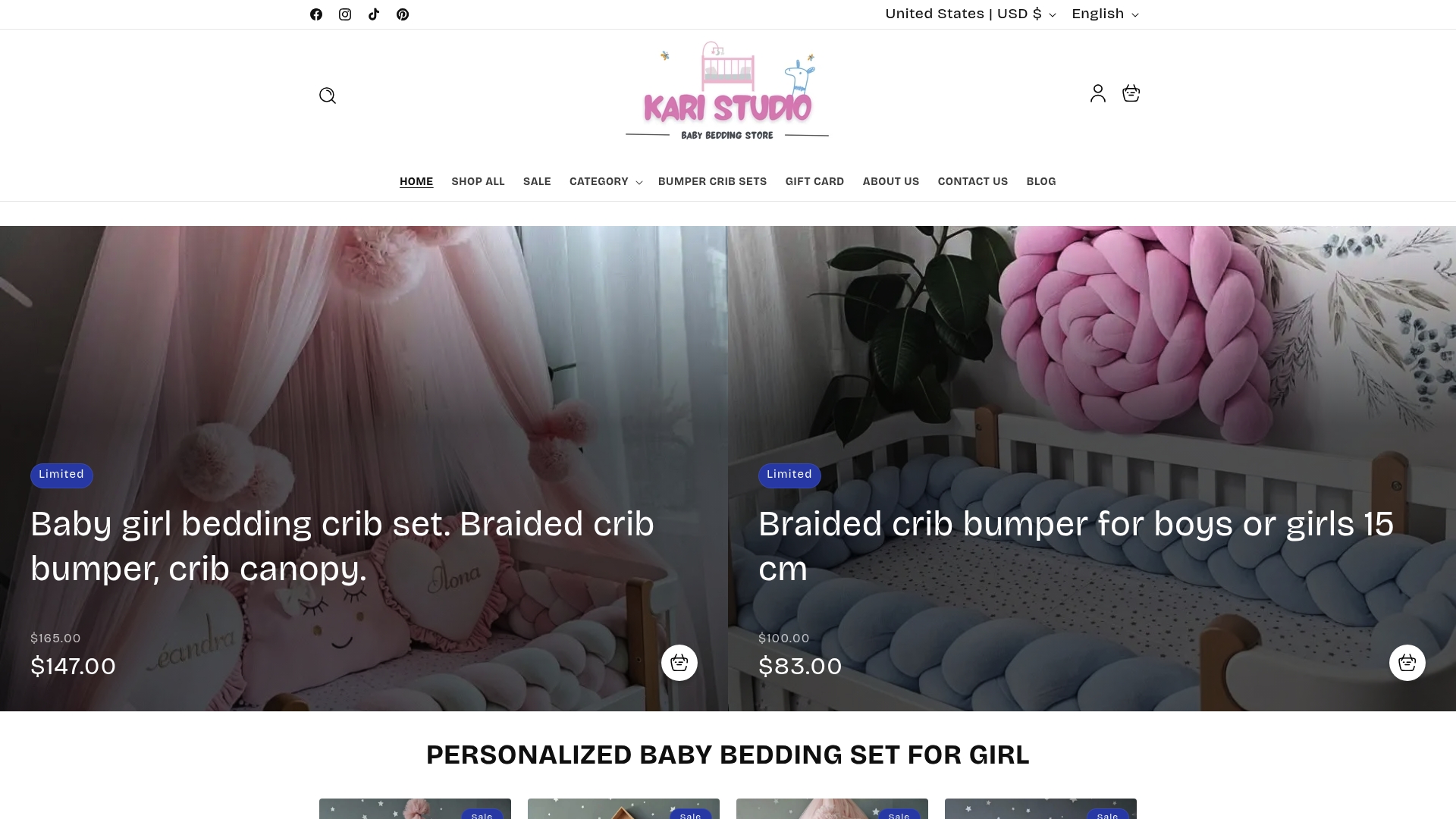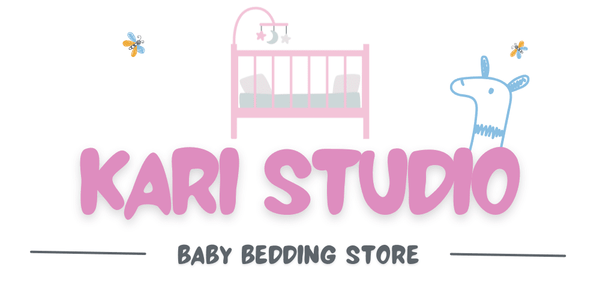
Nurseries can feel dreamy with all those picture-perfect designs online and big-box store displays calling your name. Yet most mass-produced decor misses what truly matters. Research shows that personalized visual elements and natural touches in a baby’s environment can greatly impact cognitive growth and emotional well-being. Those custom projects parents make themselves? They do so much more than decorate—they become treasured memories and powerful tools for your child’s development.
Table of Contents
- Create A Personalized Wall Art
- Upcycle Furniture For Unique Touches
- Make Custom Storage Solutions
- Design A Cozy Reading Nook
- Craft Your Own Mobile
- Paint An Accent Wall
- Sew Soft Nursery Textiles
- Incorporate Nature With Indoor Plants
Quick Summary
| Takeaway | Explanation |
|---|---|
| Create personalized wall art for emotional significance | Wall art can express your family’s identity while supporting your baby’s cognitive development. Use meaningful themes and colors to enhance your nursery. |
| Upcycle furniture to save money and add character | Transform existing items into unique nursery pieces, promoting sustainability and uniqueness while keeping costs low. Use safe materials and techniques. |
| Design smart storage solutions for organization | Custom storage not only tidies your space but also encourages independence. Use accessible, labeled storage to foster efficient organization for both parents and children. |
| Incorporate a cozy reading nook for literacy | A well-designed reading corner fosters imagination and promotes early literacy. Include soft seating and accessible book storage to make reading inviting. |
| Add indoor plants for a vibrant atmosphere | Choose non-toxic plants that enhance your nursery’s environment, providing peace and air quality benefits. Position them safely to thrive alongside your child. |
1: Create a Personalized Wall Art
Transforming your baby’s nursery into a unique and meaningful space starts with personalized wall art that reflects your family’s personality and creates a nurturing environment. DIY nursery decor ideas allow you to craft something truly special that goes beyond generic store-bought decorations.
Personalizing wall art provides more than aesthetic appeal. According to research on child development, visual stimulation through bold colors and geometric patterns supports critical cognitive development by helping infants create important synaptic connections.
When designing personalized wall art, consider these key approaches:
- Choose meaningful themes reflecting family heritage or shared interests
- Select color palettes that complement existing nursery decor
- Incorporate personal photographs or custom illustrations
- Experiment with mixed media techniques like painting, collage, or stenciling
Creating personalized wall art can be both budget-friendly and emotionally rewarding. You might design a canvas featuring your baby’s name in elegant typography, create a family tree illustration with hand-drawn elements, or develop a gallery wall showcasing cherished family moments.
Technically simple techniques like stenciling or using painter’s tape can help even novice crafters achieve professional looking results. By investing time and creativity into your DIY nursery decor, you’ll create a deeply personal space that welcomes your newest family member with love and intention.
Remember that personalized wall art isn’t just decoration - it’s a lasting memory and a visual representation of your family’s unique story.
2: Upcycle Furniture for Unique Touches
Upcycling furniture offers an innovative and eco-friendly approach to creating a distinctive nursery space without breaking the bank. By transforming existing pieces, you can craft personalized decor that tells a story and reduces waste simultaneously.
According to Habitat for Humanity of Broward, upcycling not only saves money but adds a unique personal touch to home decor while promoting sustainable practices.
When considering furniture upcycling for your nursery, explore these creative strategies:
- Repaint old dressers with non-toxic, baby-safe chalk paint
- Reupholster rocking chairs with soft, washable fabrics
- Add decorative stencils or hand-painted designs to wooden furniture
- Replace outdated hardware with whimsical knobs and handles
Potential furniture transformation projects might include converting an antique wooden ladder into a charming book display, turning a vintage suitcase into a quirky toy storage unit, or refinishing a family heirloom dresser to match your nursery’s color scheme.
Key considerations for successful upcycling include selecting durable materials, ensuring all paint and finishes are non-toxic and child-safe, and maintaining the structural integrity of the original piece. Sanding, priming, and using child-friendly paint techniques can breathe new life into seemingly worn-out furniture.
Upcycling goes beyond mere decoration - it creates meaningful pieces with history, potentially introducing your child to concepts of creativity, sustainability, and resourcefulness from their earliest days.
3: Make Custom Storage Solutions
Custom storage solutions transform nursery organization from mundane to magical, creating spaces that are both functional and visually appealing. Smart storage isn’t just about tidiness - it’s about creating an environment that supports your baby’s development and your parenting journey.
According to the Virtual Lab School, organizing materials so that both caregivers and children can easily access them is crucial for promoting independence and efficiency.
When designing custom storage solutions, consider these strategic approaches:
- Use vertical wall space with floating shelves
- Select multi-functional furniture with hidden storage compartments
- Create labeled bins for different types of items
- Incorporate hanging organizers for smaller accessories
DIY storage ideas can range from simple to sophisticated. Consider repurposing household items like wooden crates, vintage suitcases, or wire baskets as unique storage elements. Hanging fabric pocket organizers can transform bare walls into practical storage spaces for diapers, wipes, and small baby essentials.
Prioritize safety and accessibility when designing storage solutions. Ensure shelves are securely mounted, corners are rounded, and storage units are at appropriate heights. Choose materials that are easy to clean and maintain, such as washable fabrics and smooth, wipeable surfaces.
By investing creativity into your nursery’s storage design, you’ll create a space that grows with your child - functional, beautiful, and uniquely yours.
4: Design a Cozy Reading Nook
A reading nook transforms a simple nursery corner into a magical space that nurtures imagination, encourages early literacy, and provides a peaceful retreat for both parent and child. Creating this special area goes beyond mere decoration - it becomes a sanctuary for bonding and learning.
Research from Early Childhood Education highlights that intentionally designed reading spaces can significantly impact a child’s cognitive and emotional development, making literacy feel inviting and enjoyable.
When designing your nursery reading nook, focus on these essential elements:
- Select a quiet, well-lit corner away from high-traffic areas
- Include comfortable seating with soft, washable cushions
- Incorporate warm, soft lighting like dimmable wall sconces
- Create accessible book storage at child-friendly heights
Consider innovative design approaches that maximize comfort and functionality. A window seat with built-in storage, a plush oversized floor cushion, or a small rocking chair can serve as the centerpiece of your reading area. Soft, washable rugs and gentle textured throws can add warmth and tactile interest.
Lighting and atmosphere play crucial roles in creating an inviting reading space. Soft, warm lighting helps create a soothing environment that encourages relaxation and imagination. Consider using adjustable lighting options that can transition from bright daytime reading to gentle nighttime illumination.
Remember that your reading nook should grow with your child, adapting from infant storytime to independent reading adventures. Choose timeless, versatile design elements that can be easily updated as your child’s interests and needs change.
5: Craft Your Own Mobile
A handcrafted mobile transforms a simple nursery into a personalized artistic space, providing visual stimulation and creating a unique focal point that reflects your family’s creativity. DIY mobiles offer an opportunity to design something truly special that connects deeply with your baby’s environment.
According to Consumer Reports, it’s critical to ensure that mobiles are securely fastened and kept out of the baby’s direct reach to prevent potential safety issues.
When designing your custom mobile, consider these creative approaches:
- Select lightweight, baby-safe materials like felt or soft fabric
- Use neutral or pastel color palettes for visual harmony
- Incorporate meaningful themes like nature, animals, or family symbols
- Ensure all elements are securely attached with strong, durable strings
Mobile crafting techniques can range from simple to intricate. Consider using origami shapes, crocheted figures, wooden cutouts, or fabric silhouettes as hanging elements. Woodland creature themes, geometric designs, or celestial patterns can provide engaging visual experiences for your infant.
Safety and aesthetics must work together when creating a nursery mobile. Choose materials that are non-toxic, washable, and lightweight. Rotate hanging elements to different lengths for visual interest, and ensure that all connections are robust and cannot be easily pulled apart.
Remember that your handmade mobile is more than decoration - it’s a love letter to your child, crafted with intention and personal meaning.
6: Paint an Accent Wall
An accent wall offers a powerful design element that can transform your nursery’s entire aesthetic, creating visual interest and emotional depth without overwhelming the space. This strategic design approach allows you to introduce bold colors, playful patterns, or meaningful artistic elements with minimal commitment.
While specific research citations were not provided, design experts consistently recommend selecting an accent wall that serves as a focal point, typically behind the crib or changing area.
When planning your nursery accent wall, consider these essential strategies:
- Choose non-toxic, low-VOC paints safe for infant environments
- Select colors that promote calm and gentle stimulation
- Consider removable wallpaper for flexible design options
- Use painter’s tape for clean, precise design edges
Creative accent wall techniques extend beyond simple paint applications. Explore options like geometric color blocking, subtle ombré effects, hand-painted murals, or delicate stencil designs that add depth and personality. Soft, muted tones like sage green, soft blue, or warm neutral shades can create a soothing backdrop that grows with your child.
Texture and dimension play crucial roles in accent wall design. Consider techniques like color gradients, subtle shimmer finishes, or incorporating gentle textural elements that catch light and provide visual intrigue. Ensure all materials and paints are baby-safe, washable, and capable of withstanding occasional cleaning.
Your accent wall is more than decoration - it’s a canvas that tells your family’s unique story, inviting imagination and creating a nurturing environment for your newest family member.
7: Sew Soft Nursery Textiles
Sewing soft nursery textiles transforms ordinary fabric into personalized comfort for your baby’s space, creating items that are both functional and filled with love. Handmade textiles offer a unique opportunity to craft custom pieces that reflect your family’s style and provide a warm, nurturing environment.
According to The Global Montessori Network, crafting textile projects not only produces beautiful items but also develops essential skills like hand-eye coordination and concentration.
When embarking on nursery textile projects, consider these strategic approaches:
- Select soft, hypoallergenic fabrics like organic cotton
- Choose machine-washable materials for easy maintenance
- Use child-safe threads and secure stitching techniques
- Incorporate neutral or complementary color palettes
Potential textile projects range from simple to sophisticated. Consider creating soft throw pillows, delicate crib sheets, cozy blankets, decorative cushions, or fabric wall hangings. Quilted items can provide both visual interest and practical warmth, while embroidered details can add personalized touches that become cherished keepsakes.
Safety and comfort are paramount when sewing nursery textiles. Ensure all fabrics are pre-washed to prevent shrinkage, use sturdy seams that can withstand repeated washing, and avoid small embellishments that could pose choking hazards. Soft, breathable materials help regulate temperature and provide sensory comfort for your infant.
Remember that each stitch represents an act of love, transforming simple fabric into a tangible expression of care for your newest family member.
8: Incorporate Nature with Indoor Plants
Introducing indoor plants into your nursery creates a living, breathing environment that connects your baby with nature’s calming and developmental benefits. These green companions do more than decorate - they actively contribute to a healthier, more nurturing space.
According to National Institutes of Health research, indoor plants can significantly reduce psychological stress and enhance mood, making them an excellent addition to nursery design.
When selecting plants for your nursery, consider these essential guidelines:
- Choose non-toxic, child-safe plant varieties
- Place plants out of infant’s direct reach
- Select low-maintenance species that thrive in indoor conditions
- Use sturdy planters with secure bases
Ideal nursery plant options include spider plants, Boston ferns, pothos, and snake plants. These varieties are known for their air-purifying qualities, minimal care requirements, and safe characteristics. Consider using hanging planters or wall-mounted containers to keep plants safely away from curious little hands while maintaining visual appeal.
Safety and placement are crucial when incorporating plants into nursery design. Ensure all plants are positioned securely, using wall mounts or high shelves that prevent accidental toppling. Opt for plants with soft, non-sharp leaves and avoid species with toxic elements or those prone to shedding small, potentially hazardous parts.
Your indoor plants become more than decor - they’re living lessons in growth, care, and the beautiful complexity of the natural world, introducing your child to botanical wonder from their earliest days.
Below is a comprehensive table summarizing the 8 inspiring DIY nursery decor ideas covered in the article. This table presents the main focus of each idea, its core benefits, and important considerations or tips to help you implement them in your babys nursery.
| DIY Idea | Key Benefit | Tips & Considerations |
|---|---|---|
| Personalized Wall Art | Supports cognitive development, emotional meaning | Use meaningful themes/colors, personal photos, and simple techniques |
| Upcycled Furniture | Eco-friendly, cost-effective, adds unique character | Use non-toxic materials, ensure safety, check structural integrity |
| Custom Storage Solutions | Keeps nursery organized, encourages independence | Opt for accessible/labeled storage, maximize vertical and hidden spaces |
| Cozy Reading Nook | Fosters literacy, imagination, and bonding | Choose soft seating, good lighting, child-level book storage |
| Handmade Mobile | Provides visual stimulation, personalized touch | Use safe, soft materials, secure hanging, keep out of reach |
| Painted Accent Wall | Adds visual interest, character, and flexibility | Pick low-VOC paint, soft colors, try stencils/tape for clean design |
| Sewn Nursery Textiles | Offers comfort, style, and personalized details | Select hypoallergenic fabrics, use washable, child-safe materials/stitches |
| Indoor Plants | Improves air, adds calm, introduces nature | Use non-toxic species, place securely, choose low-maintenance types |
Ready to Turn DIY Dreams Into Everyday Comfort?
You have just explored eight unique ways to add personal touches and emotional warmth to your baby’s nursery, from upcycled furniture to handcrafted textiles. But sometimes creating a beautiful and safe space can feel overwhelming, especially when you want custom details yet also need reliable essentials like crib bumpers, soft accessories, and clever storage. If you are looking for quality pieces to match your vision, Kari Studio helps you bridge creativity with convenience.

Discover a world of nursery inspiration and practical products that make your next DIY project easier. Browse Kari Studio today for unique nursery accessories designed to fit your personal style and give your baby the comfort they deserve. Find ideas, shop with confidence, and bring your dream nursery to life now!
Frequently Asked Questions
What are some unique ideas for personalized nursery wall art?
Creating personalized wall art can include themes that reflect family heritage, using color palettes that match nursery decor, and incorporating personal photographs or custom illustrations. Techniques like stenciling or collage can also add a special touch.
How can I safely upcycle furniture for my nursery?
To upcycle furniture safely, choose non-toxic, baby-safe paint, ensure structural integrity, and remove any sharp edges. It’s essential to use durable materials and maintain easy accessibility for practical use.
What are some effective storage solutions for organizing nursery items?
Effective storage solutions might include using vertical wall space, selecting multi-functional furniture with storage compartments, and creating labeled bins for different types of items. Hanging organizers can also optimize space for smaller accessories.
How can I create a cozy reading nook in my nursery?
To create a cozy reading nook, choose a quiet corner with comfortable seating, warm lighting, and accessible book storage at child-friendly heights. Include soft rugs and cushions to create a welcoming atmosphere.

